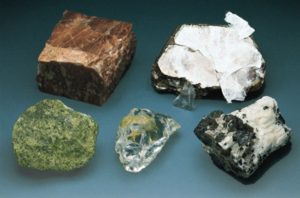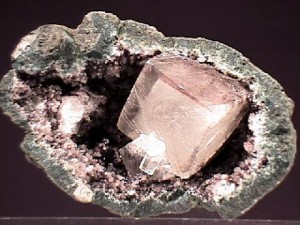Minerals are solid chemical compounds that combine to form rocks. They are found in nature and vary in atomic bonding, molecular structure, and element composition, all of which determine their chemical, physical properties and permit their identification.
‑ An infinite number of chemical combinations are possible and almost 4000 natural minerals are known; however, only about 20 minerals dominate the Earth’s crust
Common Minerals: natural solid compounds found commonly in Earth’s crust
 Silicates – most abundant; made of the silicon-oxygen tetrahedron (silica, (SiO4)-4) bonded to various metallic cations
Silicates – most abundant; made of the silicon-oxygen tetrahedron (silica, (SiO4)-4) bonded to various metallic cations
ferromagnesian (dark) silicates: contain Fe+2 and Mg+2 cations
olivine – covalently-bonded silica tetrahedra surrounded by Fe, Mg cations; Fe, Mg substitute for each other to form a family of minerals; pyroxene – single chains of tetrahedra ionically bonded to metallic cations, nearly right angle cleavage; amphibole – double chains of tetrahedra ionically bonded to metallic cations, 120° cleavage; biotite – tetrahedral sheets ionically sandwich K+, perfect platy cleavage
nonferromagnesian (light) silicates: muscovite – tetrahedral sheets with perfect platy cleavage; feldspar – strongly bonded 3-D network of silica tetrahedra, K variety is called orthoclase and Ca-Na family is called plagioclase; quartz – made entirely of silica tetrahedra (SiO2) covalently bonded, hard, has no cleavage
Carbonates – metals bonded to (CO3)‑2 group to form minerals like calcite (CaCO3; used for lime, cement) and dolomite (CaMg(CO3)2)
 halite (NaCl; table salt) and gypsum (CaSO4· 2H2O; used to make plaster and drywall) are formed by evaporation of ancient shallow seas and salt ponds
halite (NaCl; table salt) and gypsum (CaSO4· 2H2O; used to make plaster and drywall) are formed by evaporation of ancient shallow seas and salt ponds
Ores of metals include hematite (Fe2O3; iron ore), sphalerite (ZnS, zinc ore), galena (PbS; lead ore), and native gold and silver that are important to our economy
Conclusion:
‑ many minerals tend to occur together because they were formed under similar pressure and temperature conditions, but with different combinations of elements
‑ minerals can be transformed into new minerals by being transported to another part of the rock cycle – the new minerals form from previous ones as pressure and temperature conditions change in the new environment
